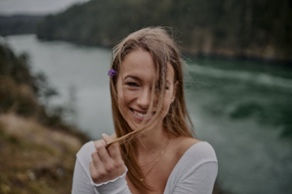Capturing Color
- Josie Woosnam
- Nov 4, 2021
- 4 min read
Updated: Jul 5, 2022
Written By Josie Woosnam
During this overwhelmingly beautiful season change, there are bright colors in every direction we look. The weather starts to get a bit chillier as the leaves on almost every tree turn a vibrant yellow, orange, or red. With just a few simple tips, I’m going to show you how you can capture some of those radiant colors through the art of photography.
Step 1: START WITH A CAMERA
This can be a heavy-duty professional camera with several different settings to better equip you with everything you might need to capture colors, or it can be as simple as the camera on your phone. Either way, make sure you are familiar with several of the settings before beginning. In addition to a camera, you can incorporate props and lighting based on what you want to take a picture of.

Step 2: GET YOUR CREATIVE JUICES FLOWING
Pick an object(s) that stands out to you, whether it be because of shape or color. If you’re not sure what you want to take a picture of, think about objects, whether they be people or everyday objects, that spark strong emotion. *Remember pictures are meant to display different emotions, and they don’t always have to make perfect sense. Pictures mean various things to different people, but an important thought to keep in mind is that you are the author of this story you are about to display through captured color. Think about what you are capturing and what it means to you. In my opinion, this is one of the most essential steps in taking pictures.
Step 3: WITH COLOR, REMEMBER LESS IS MORE
Focus on a few colors or keep your picture to a general color scheme rather than bombarding the empty spaces with lots of different colors. Multiple different colors in a photo can be overwhelming and sometimes come off as messy-looking or chaotic. Once you have a subject(s) chosen, you can work on position and lighting. This is where colors come in.


Step 4: POSITIONING
When positioning an object, professional photographers use the rule of thirds. This rule states, for better pictures, you should use a 3x3 rectangle grid on top of your photos and place critical elements of your scene at one or more areas in the image. To incorporate this rule into your pictures, it’s vital to have at least one object be your focal point and to have that object featured in several sections within the rectangle. For more professional-looking photos, photographers tend to place the object they want peoples’ eyes to focus on in an area that takes up several sections in the picture to draw attention. In the end, you don’t want a bunch of empty space on your picture; take advantage of that space and fill it with objects that add to the picture’s overall story. Based on where you position your object(s), you can adjust the lighting as needed. You may not always be able to control the light, but you can control where you place your subject and where it is relative to the direction the light hits.

Step 5: LIGHTING
Remember that light looks better when it is shining towards an object rather than behind it. Natural light makes for better pictures, but the flash is your friend! Use it to your advantage! For the best lighting, go outside on a somewhat overcast day; that way, your pictures aren’t too overexposed, but you have enough natural light that is easy to work with when editing. For golden hour photos, aim to go outside 30-45 minutes before sunrise/sunset.



Step 6: ENHANCING COLOR WITH EDITING
Every picture is different, which means editing will never be the same for every photo, but here are some helpful settings to know when preparing to edit. Remember, this is where your creativity comes in! The lighting and color enhancements are based on your taste and what you think makes the picture look best!
Exposure -When adjusting exposure, the higher you make it, the brighter the picture gets. This is helpful when the picture turns out a bit dark.

Contrast -This is the range of light and dark tones. When this is high, you see a variety of different tones ranging from light to dark based on the picture. When contrast is low, your image tends to be more flat looking.

Vibrancy and Saturation -After playing around with lighting, you can adjust colors! (my favorite) You can further refine colors within your photos by making both the vibrancy and saturation levels higher. By increasing these, you can really make colors stand out.

Sharpness -Lastly, to help with clarity, you can adjust sharpness. While this is an excellent tool for unblurring photos, you have to be careful with this one because if you enhance the sharpness too much, your picture can turn out grainy. Carefully look at individual areas to evaluate the effects sharpness can have on your picture.

Almost everywhere you turn, you can see colors, and with photography, we can incorporate those colors into the art of picture taking. From staging objects to adjusting lighting, photography is a wonderful way to capture bright colors ranging from colors you see all around you every day, to colors you tend to notice only during the change in seasons. Hopefully, these tips helped you get one step closer to truly appreciating the beautiful masterpieces handmade by our Creator all around us.
Works Cited
Photo editing basics: How to edit photos. How to Edit Photos | REI Co-op. (n.d.). Retrieved October 28, 2021, from https://www.rei.com/learn/expert-advice/photo-editing-basics.html.





Comments